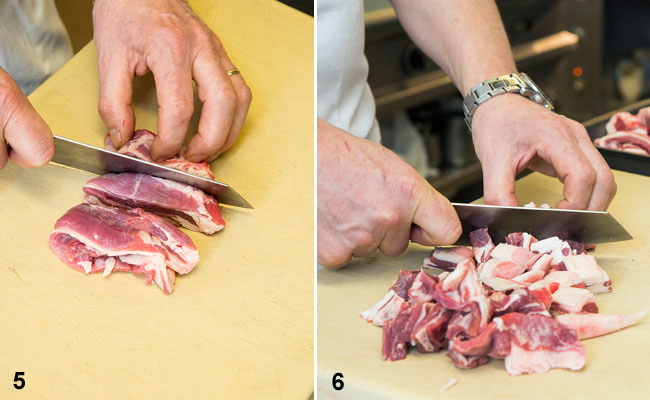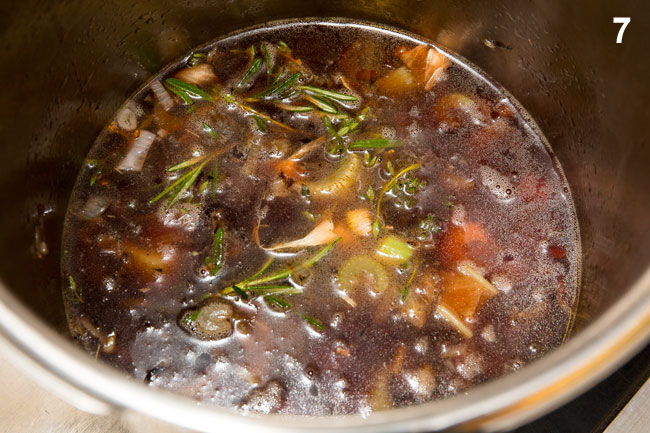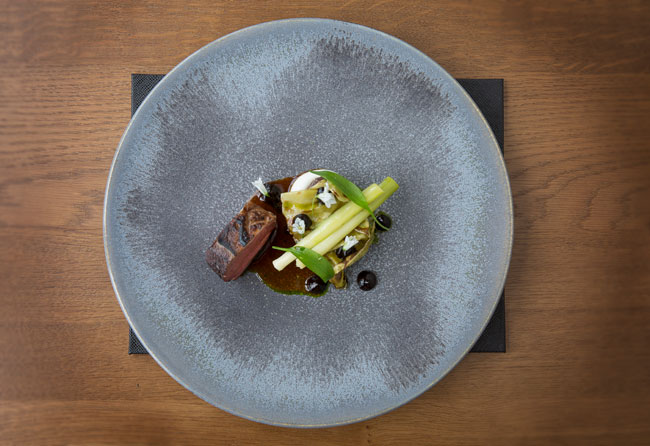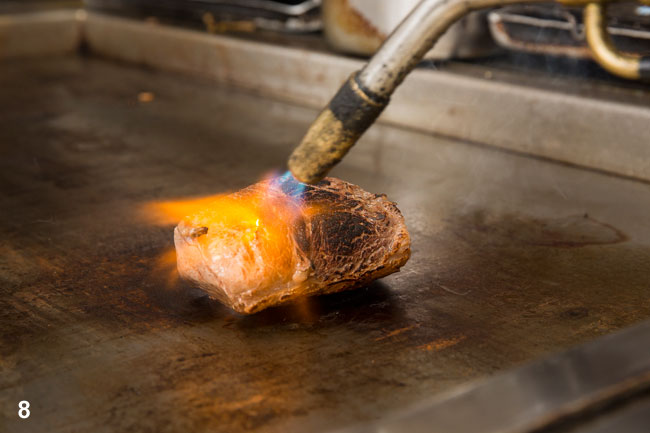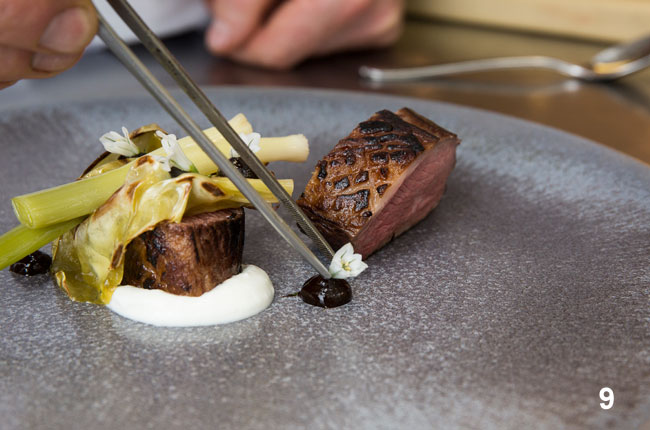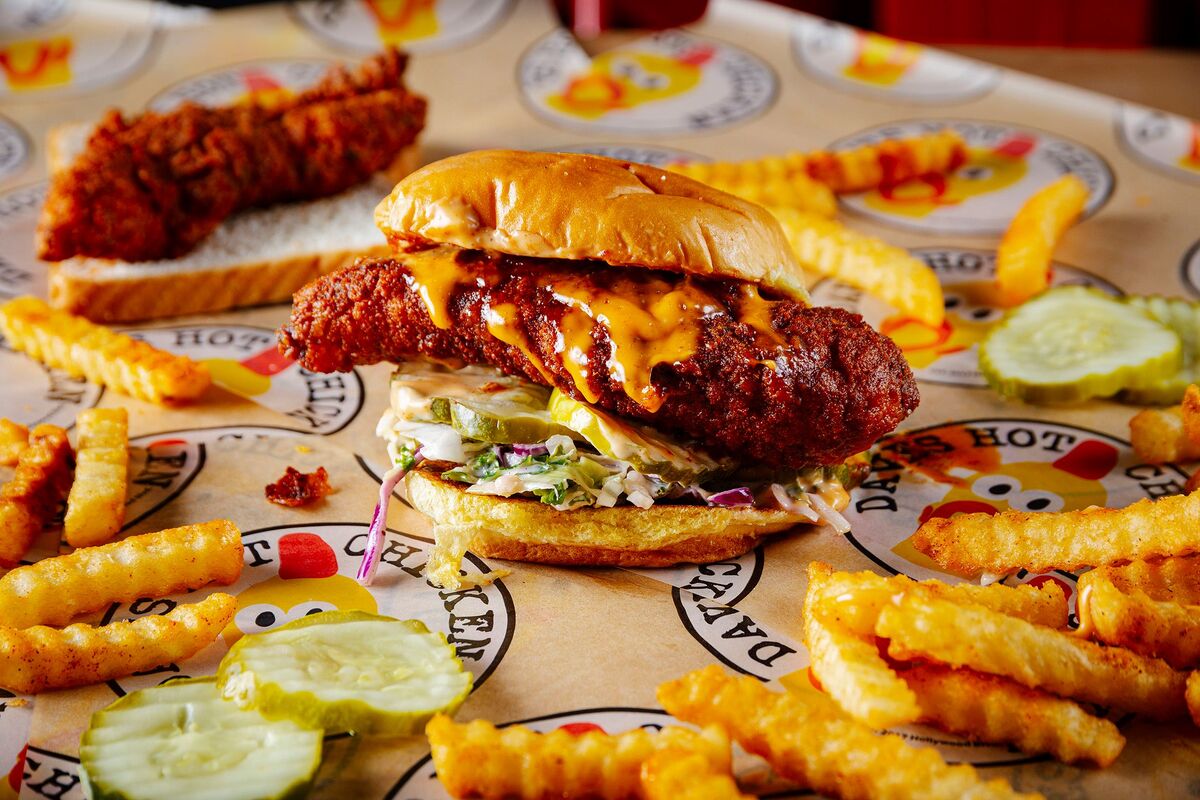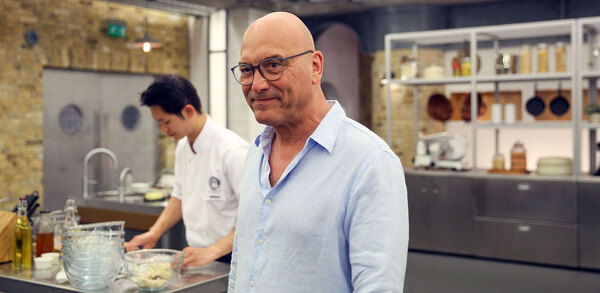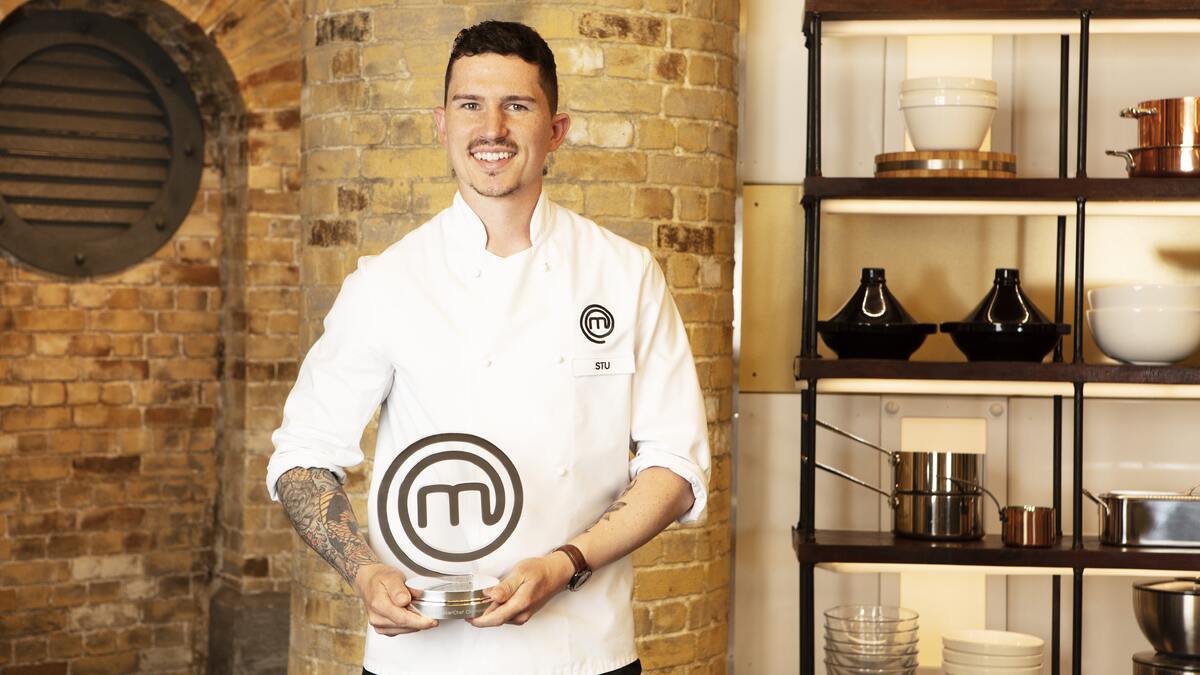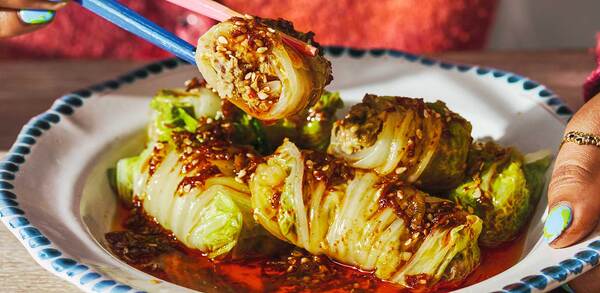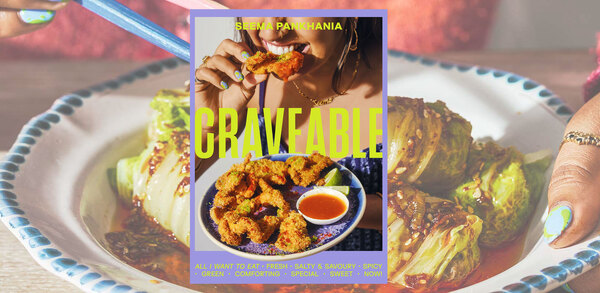Chef masterclass: Roast lamb, Simpson's-style
Luke Tipping, chef-director at Simpsons in Edgbaston, brings a dining-room classic bang up to date with some modern flourishes. Michael Raffael reports
How far and fast have professional cooking techniques changed? Simpson's- in-the-Strand in London was an iconic restaurant of the early and mid-20th century, when it had two specialities.
One was roast rib of beef, and the other was a saddle of Southdown lamb carved, parallel to the backbone, at the table. Simpsons in Birmingham (no relation) has a different approach to cooking the ‘roasted' Cornish lamb it serves in spring and early summer. It involves brining, induction searing on a griddle, vac-pack cooking, reheating and blowtorching.
Simpson's à la 1960 offered up its lamb with roast potatoes, mint sauce, Savoy cabbage and gravy. Chef Luke Tipping's 2017 dish at Simpsons in Birmingham includes pickled Hispi cabbage, pencil leeks, Thermomixed wild garlic oil, black garlic, ewe's curd and a lamb jus prepared in a pressure cooker.
The contrast between the two shows the widening gap between mainstream cooking as it was (and still is, for the majority of kitchens) and chefs who are aspiring to cook at the Michelin Guide's table.
Methods may have changed, but the reason for the transformation in approach goes deeper than a desire to impress the customers. When diners ate at Simpson's back in the day, they tipped the carver. Not everyone received perfect slices of the roasted meat.
In restaurants associated with a named chef's talents, consistency rules. Favouring one customer over another, either by accident or on purpose, therefore isn't an option. However creative a chef may be, they still have to deliver dishes with the reliability of a Big Mac.
The risk of falling short on quality explains why so much emphasis hinges on mise en place. Head chefs are the designers and producers who control the show. If their kitchens are much quieter during service than they were in the heady 1990s and early 2000s, that's because the work of their brigade has reduced the chance of error early on, at the preparation stage.
Planning
â- The lamb sauce is prepared daily in small quantities using an oven and a pressure cooker.
â- The lamb chumps are seared, brined, vacpacked and poached ahead of service. During service they need reheating and blowtorching.
â- Pencil leeks are vac-packed with virgin rapeseed oil and steamed in batches daily.
â- Garlic oil is a routine Thermomix process.
â- Eweâs curd and black garlic purée are made for one to two daysâ service.
Costing
Simpsons, open five and a half days a week, has food costs fluctuating between a 65% and 70% GP. It serves a £90 tasting menu, a simple three-course £65 à la carte and a £35 three-course lunch menu. The lamb dish requires a 200g raw weight lamb chump for the à la carte or two tasting menu portions.
Pickled Hispi cabbage
Simpsons serves one leaf per main course or a torn leaf for a tasting menu portion. This averages out at between 16 and 20 servings per cabbage.
Work in multiples of two cabbages per large-size vac-pack. Split the cabbages in half (1) and pack all four halves with 3% salt by weight â" about 15g (2). Seal the bags on maximum pressure and leave for two weeks (3). Sear them cut-surface down on an oiled griddle until lightly coloured (4). Reseal in a fresh bag for four to five days or until needed.
Lamb sauce
Batch size here is for about 750ml, enough for about 50 portions. On busy days the restaurant may make a double batch.
1kg lamb breast
100ml olive oil
200g shallots, diced
80g carrot mirepoix
80g celery mirepoix
1 head of garlic cloves
2 bay leaves
Sprigs of fresh thyme and rosemary to taste
500ml Madeira
500ml dry white wine
1 litre basic chicken stock
1 litre brown chicken stock
Salt
Optional beurre noisette to finish the sauce
Dice the lamb breast into small pieces (5-6). Put the pieces in a roasting tin and brown for 30 to 40 minutes at 220ºC. The lamb will render a lot of fat, which should be drained off.
Heat the oil in the bottom of a pressure cooker. Add the vegetables and fry them over a hot heat until they colour. Add the herbs and deglaze the pan with the wine and Madeira.
Add the meat and stocks (7). Seal the pressure cooker and cook for 40 minutes.
Release the pressure and let the sediment settle. Pass the jus into a clean pan and reduce to a light coating consistency. Season. When finishing the sauce you may incorporate a little beurre noisette.
Chumps
Simpsonâs buys centre-cut chumps (similar to Eblex code L028) with a light fat cover, weighing 200g each.
Prepare a 10% (100g of salt to one litre of water) solution and brine the chumps for an hour. Sear them on the griddle and then vac-pack them individually. Poach in a water bath for 90 minutes at 62ºC and then chill rapidly. Reserve until service.
Pencil leeks
Prepare in batches of about 30 leeks per large vac-pack. Trim the roots and pack the leeks into the vac-pack bag. Prepare a bouquet garni of 4g each of coriander and fennel seeds. Add it to the bag along with approximately 80ml of virgin rapeseed oil and seal. Steam for 10 to 12 minutes at 100°C.
Wild garlic oil
Work with multiples of 100g of wild garlic leaves to 200ml of sunflower oil.
Put the oil and herbs in the Thermomix and heat slowly to 90°C. Blend for five minutes at this temperature and then strain through a fine sieve. Keep in a
squeezy bottle for service.
Black garlic purée
Black garlic cloves are aged under controlled humidity. Simpsons buys the Balsajo brand. Allow about 10g of purée per portion. Put 200g of black garlic cloves in a pan with just enough veal stock to cover. Bring to the boil and blitz. Keep in a squeezy bottle for service.
Roasted Cornish lamb chump, Hispi cabbage, wild garlic, sheepâs curd and lamb sauce
Serves 1 (as a main course)
1 slow-cooked chump
1 pickled Hispi leaf
10g eweâs curd
2 warmed pencil leeks, green ends trimmed
10g (approximately) black garlic purée
40ml lamb sauce (reheated with the beurre
noisette if used)
Wild garlic oil
Garlic flowers
Put the chump in a very hot (220ºC) oven for three minutes to start heating through. Take it out and blowtorch it all over to give a suggestion of charring (8).
Cut it into two pieces (note: on the tasting menu, there are four slices and the presentation is different too).
Sear the pickled cabbage leaf on an oiled griddle to colour it lightly. Pipe the eweâs curd on the plate and stand the meat on it. Put the leaf on one piece of meat, followed by the leeks. Pipe dots of garlic purée around the meat. Pour or spoon on a little sauce. Finish with a trail of garlic oil and a few flowers (9).
Luke Tipping
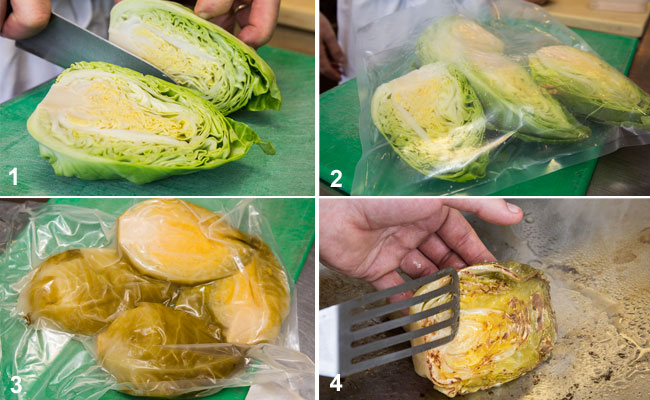
Tipping is now 52 and chef-director at Simpsons, Edgbaston. Two generations separate him from his apprenticeship. Kitchens have changed, techniques have changed, attitudes to staff have changed and Britainâs second city can now boast five-starred restaurants. He has stayed young, he claims, because âIâve never lost my appetite for cooking.â
What hasnât altered has been the thread connecting his style of cuisine to the roots that inspired him as a young man. âWhen people talk about modern British cookery, I often wonder what they mean, because chefs like Marco Pierre White and Gordon Ramsay all got their basics from the French,â he says.
Tipping worked under Andreas Antona at the Plough and followed him to Kenilworth, to the site of Simpsonsâ original incarnation. When Antona relocated to Birmingham 13 years ago, Tipping went with him as executive chef and
then as director of the company. They operated a successful business for a decade until, Tipping claims: âWe realised we were running on half-steam. We needed to put some energy back into it. We could have given the place a lick of paint and just carried on because we were doing well, but we felt that the dynamics of the city had changed. There were a lot more young people eating out.â
The overhaul transformed Simpsons. It increased the dining room size to 70 seats plus a private dining room. An upstairs cookery school and development kitchen is about to reopen after a refurbishment. The atmosphere hovers between Scandinavian and Mediterranean. And, more importantly, the dishes match the setting in colour and elegance.
Tipping views the kitchenâs output as the result of working with a young team: âIÂ like to see myself as one of the lads, but Iâm still the captain.â His brigade is built around young, local men and women, from his head chef Nathan Eades to the 16-year-old apprentice who is spending two and a half years in the kitchen as part of a Royal Academy of Culinary Arts scheme.
Supporting this chef of the future is very different from the hardcore experience that helped shape Tipping: âThe 16-year-old is working with me roasting the bones. He has all our recipes. Heâs making sauces and itâs down to him what he makes of the opportunity,â he says.



